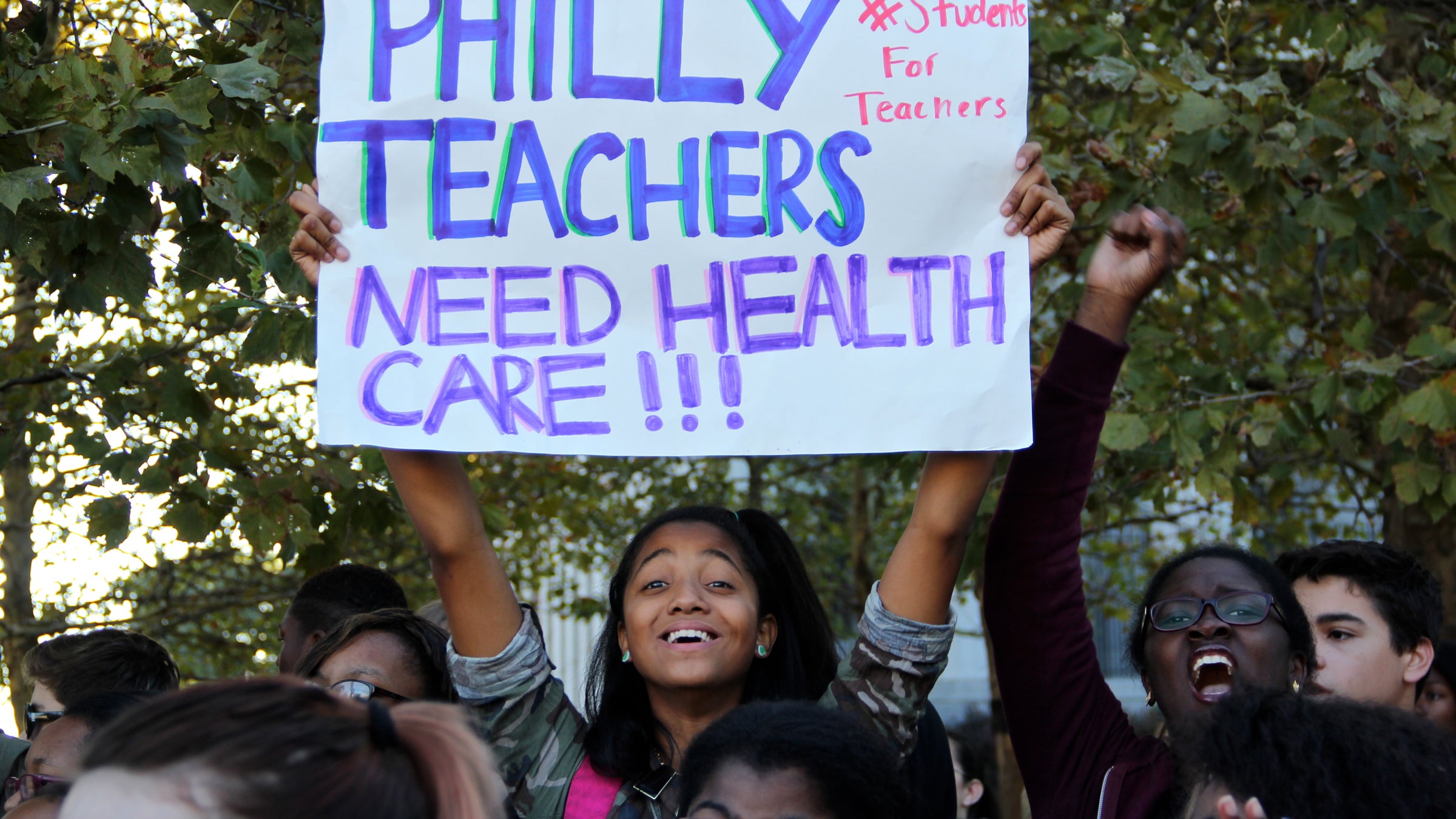Health care concessions a tough pill to swallow for city teachers
Listen
Students protest on behalf of their teachers during a demonstration at the Philadelphia High School of the Creative and Performing Arts. (Emma Lee/WHYY)
Speech and language pathologist Sonya Brintnall has been dreaming lately of the Pacific Northwest.
“I used to live in Oregon,” she said. “I could go back there, and I could be poor and have nothing, but it would be beautiful.”
Brintnall, who works at Greenfield Elementary in Center City, is one of 11,500 members of the Philadelphia Federation of Teachers whose contracts were terminated last week by the School Reform Commission in a surprise, unilateral move.
With the contract out of the way, the district intends to pump additional and badly needed funds into schools by getting teachers to contribute toward health care costs.
Contending that the SRC acted illegally, the union plans to challenge the move in court.
For Brintnall, the action has repercussions on many levels. Her husband also teaches in the district, and her two children attend Philadelphia public schools where resources are bare and teachers are increasingly disgruntled.
“Being here, I make a sacrifice [that affects] my kids,” she said. “They have no art class. My daughter has no art at all. They don’t have supplies, resources. I’m giving up so much because I love walking to work and living in the city, but, at some point, the math doesn’t work out.”
Here’s the math: Philly teachers have lower average salaries compared with almost all surrounding school districts, but one of the major perks has been that they haven’t had to contribute to their health care premiums. With last week’s surprise move, teachers suddenly must budget for a significant reduction in take-home pay.
When district leaders have publicly discussed the burden on teachers, they’ve cited single-coverage rates for the higher deductible plan that carries high out-of-pocket maximums.
“By requiring new monthly contributions — $26 to $67 for individual coverage and up to $200 for family coverage — the district will be able to reallocate funds and restore resources that our schools currently lack,” wrote Bill Green, chairman of the School Reform Commission, in an opinion piece published in Sunday’s Inquirer.
But to cover a family under the security-providing “buy-up” plan, teachers would actually spend more than $500 per month. This covers a quarter of the total premium, which is a significantly higher burden compared with suburban compensation packages.
That’s causing Brintnall to rethink her options.
“Because I’m in a highly needed field of speech/language pathology, I could have a different job tomorrow, I hate to tell you,” she said during an interview in Greenfield’s schoolyard. “I get cold calls asking me to work. So I was just like, maybe I should quit.”
When her colleague at Greenfield, Jackie Serra, did the math, between this expense and the cost of child care she concluded that “financially it may make sense for me to be a stay-at-home mom.”
Breakdown
Below is a breakdown of the costs teachers would incur under the “base plan” – the plan Green referenced above – which covers only 90 percent of health insurance costs after a deductible is met.
For individuals, the deductible is $300 and the maximum out-of-pocket cost is $6,350. For family coverage, the deductible is $900 and the maximum out-of-pocket cost is $12,700.
Prices here are per pay period, of which there are 26. Yearly cost is depicted in parentheses.
|
*A $70 surcharge is added per pay period to cover a spouse or domestic partner who is eligible for health coverage through thier own employer.
Under this plan, a PFT member earning more than $55,000 would pay $2,606 in premiums to cover a family of four.
But since the plan only pays 90 percent of health care costs, a teacher would potentially be on the hook for $12,700 if yearly medical expenses met or exceeded $127,000.
‘Buy-up’ plan
The next table shows the cost of the “buy-up” plan, which carries no deductibles and covers 100 percent of in-network health care costs.
For individuals, the maximum out-of-pocket cost is $1,000; for family coverage, it’s $2,000.
Again, prices here are per pay period, of which there are 26, and yearly cost is depicted in parentheses. Neither chart includes dental, vision or prescription expenses.
|
This graph clearly shows that if teachers decide to purchase the health plan with lower deductibles and out-of-pocket maximums they’d spend a much higher percentage of the premium than district and SRC leaders have been touting in public.
Total cost of premiums are calulated based on publicly available information on the district’s website.
When Central High School history teacher George Bezanis crunched these numbers and compared his options to his those of his counterparts in surrounding districts, he found that he’d be much better off leaving Philadelphia.
With a wife and two young children, Bezanis said he’s always considered whether it was worth it to remain in Philly. Until last week, the math always added up on the side of staying.
A few years ago, he turned down an offer from Springfield School District in Delaware County because he says he loves the diversity of students at Central.
“I’ve never looked back at that choice,” he said, “but I’m starting to now.”
District leaders say they understand that imposing health care costs could spur some staff to leave, but they say the move was necessary to shore up classroom resources – more than $50 million worth this year and more $200 million worth over the next four years.
“What we’re trying to do is get resources back into schools,” explained schools Superintendent William Hite in a press conference after the SRC vote. “We’re also trying to take the least onerous way to do that. It’s why we took wage reductions off the table in our negotiations.”
Still, many teachers believe the SRC’s action has actually undermined long-term classroom success.
“You make this extremely undesirable job, and all you’ll have is a bunch of young temp workers that come in for two or three years and then leave,” said Amy Roat, founding member of the Caucus of Working Educators and teacher at Feltonville Arts and Sciences.
“I think it could potentially destroy a true teacher corps in the city,” she said, “and I don’t think that people are going to be happy with what that looks like five years from now.”
WHYY is your source for fact-based, in-depth journalism and information. As a nonprofit organization, we rely on financial support from readers like you. Please give today.





